January 1945 QST
 Table
of Contents Table
of Contents
Wax nostalgic about and learn from the history of early electronics. See articles
from
QST, published December 1915 - present (visit ARRL
for info). All copyrights hereby acknowledged.
|
Did you know that you are likely a TLV? That's
right, a Television Looker. The modern equivalent is CP - Couch Potato. In the early
years of television, TLVs were as fascinated with the device itself and the technology
as they were with the information being displayed. As this story tells, Hams were
involved in TV transmission (ATV) early on. I did not know that amateur television
was banned during World War II. During WWII, all amateur radio operations were suspended
with the exception of those authorized to continue under the Radio Amateur Civil
Emergency Service (RACES).QST Looks at Television - 1944
The "State of the Art" from an Amateur Viewpoint
By Cyrus T. Read, W9AA
For many years leading experimenters in the amateur ranks have interested themselves
in television and some notable work has been accomplished. Since Pearl Harbor all
amateur television has of course been discontinued, but the commercial broadcasters
have continued to experiment and plan for the future. QST presents herewith an account
of present-day television as it looks from the amateur viewpoint.
Of all the electronic miracles which have been promised to the postwar world
the most widely anticipated probably is television. Ever since the early days of
radio broadcasting the possibility of being able to see as well as hear by radio
has intrigued the public's imagination and every faltering step forward in this
new art has been eagerly hailed with the statement that "television is just around
the corner." This great public interest, accompanied as it has been by many irresponsible
predictions of immediate availability, has not been an unmixed blessing. There is
no television equivalent for the crystal detector or simple one-tube receiver -
even the crudest early attempts at video transmission by means of rotary scanning
discs required comparatively complicated equipment - and most of the serious workers
in the field have done their best to head off premature promotion.
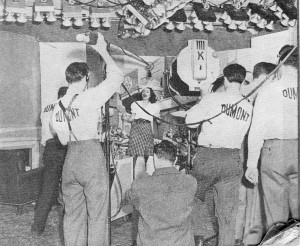
The studio staff at WABD during the televising of "Parisian Memories."
It takes a full size crew to operate all of this para-phernalia. The man in the
left foreground is manipulating the microphone boom to pick up the singer's voice
without letting the mike show in the picture.
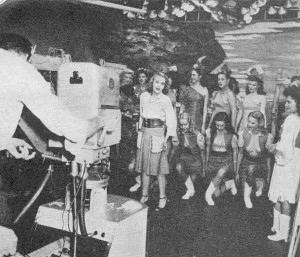
WABD has presented many interesting shows. Here is a scene from
"The Boys From Boise," broadway musicomedy that was transmitted complete with orchestra,
chorus girls, and all the trimmings
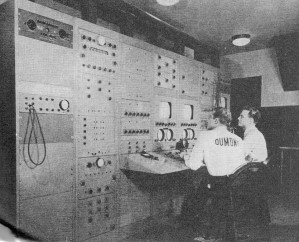
The main control room at WABD. The large monitoring scopes have
14 inch screens and reproduce the picture in black and white.
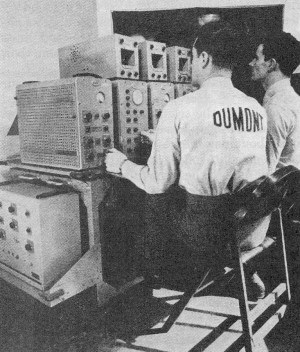
The control room of Studio A. The small monitors on top use the
familiar 5·inch oscilloscope tube. The picture is green hut these tubes serve the
purpose until new equipment is available,
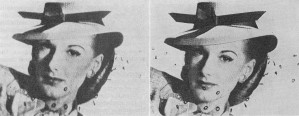
Which is which? One of the above pictures is from an original
8 X 10 photograph and the other shows bow it appears after having been transmitted
by television. You pick 'em out.
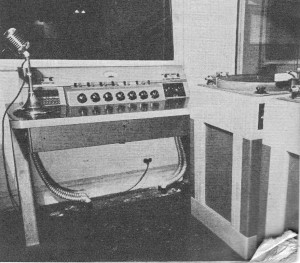
Turntables and main sound control panels at WABD.
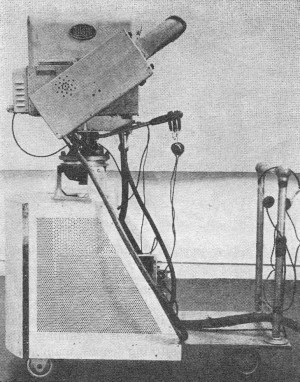
A camera dolly carrying iconoscope camera, electronic viewfinder
(using another green 5 inch tube) and power supplies "for iconoscope, preamplifier.
etc.
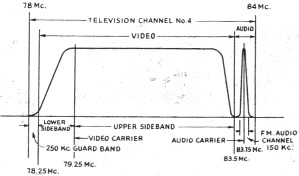
Fig. 1 - Television channel No.4, showing how the six megacycles
between 78 and 84 are used by WABD. The video carrier is amplitude modulated and
has it. lower side band partially suppressed.
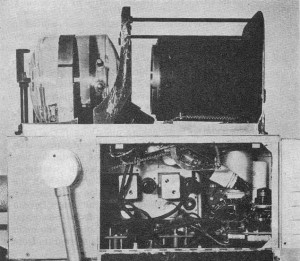
Television camera opened to show arrangement of parts. The iconoscope
tube is at the upper left with base including electron gun slanting down to the
right. Lens equipment for focusing picture on the screen of iconoscope is at the
upper right. The bottom cabinet contains the preamplifier with the input tube placed
as close to the Ike screen as possible.
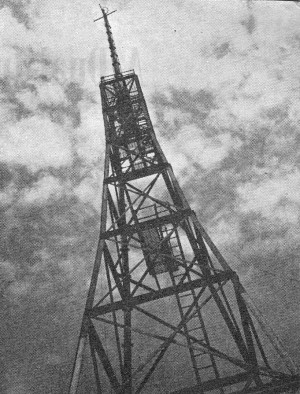
Antennas of WABD, station of the Dumont Television Corporation
atop the 515 Madison Ave. Bldg., New York City. The folded dipole is the video antenna,
the doughnut is for the accompanying sound.
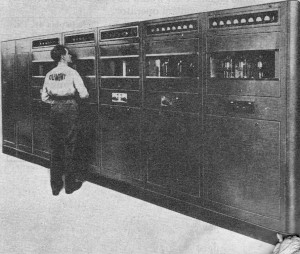
The transmitters at WABD. Panel at extreme left contains exciter
and modulator for f.m. sound channel. Unit at the right contains final amplifier
for sound. The rest of the equipment is all video.
The eventual place of television in amateur radio is not yet clear. As early
as 1925 QST carried articles about the scanning disc systems of that day and since
then has consistently presented the facts about new developments in the art when
they seemed to offer possibilities for amateur use. At the same time the limitations
and problems still to be overcome have been clearly set forth, a notable instance
of "debunking" being the article, "Television - What About It?" which Ross Hull
wrote in 1931.1 Late in 1937 QST started on a systematic development
program for amateur television. An introduction by James J. Lamb2 was
followed by a series of articles on modern cathode-ray television adapted for amateur
use, which were discontinued only when war put a stop to most amateur experimentation.
This report on today's television is not intended as a continuation of that series
but, rather, is an appraisal of the present situation as a whole, an attempt to
shed a little light on what has recently become a most controversial subject.
For the past many months the writer's principal duties have been to attend meetings
and read voluminous reports, anything and everything that might conceivably have
an impact on amateur frequencies. In the process he has been privileged to attend
various panel and committee meetings of the Radio Technical Planning Board, meetings
of the State Department's committee on radio allocations, and the recent hearings
of the Federal Communications Commission. At many of these, television was the principal
subject and the heated discussions between adherents of the present standards and
frequencies and those who want to use more scanning lines and move to the u.h.f.
region were strongly reminiscent of the 'phone-vs.-c.w. or high-vs.-low power arguments
in amateur circles. QST, of course, is neutral regarding the television controversy
as this is not an amateur matter. However, no dyed-in-the-wool ham can remain completely
unmoved in the presence of a real good scrap over technical matters, so we determined
to find out "what the shootin' was all about." Through the courtesy of Dr. Allen
B. DuMont, ex-W2AYR/W2AHD, and Dr. T. T. Goldsmith, director of research for the
DuMont Corp., we had the opportunity to visit WABD and inspect a modern television
station.
WABD in Operation
WABD is on the air three nights a week from 8 until usually about 11 P.M. Practically
the entire staff of engineers and technicians is made up of regular DuMont employees
who are operating this television station on an overtime basis in addition to their
full-time job of war production in the plant at Passaic, N. J. As might be
expected, most of them are amateurs or have an amateur background.
While WABD operates under a commercial license and many sponsored shows are regularly
transmitted, the entire setup is still of a more or less experimental nature. DuMont
provides all of the technical facilities and personnel but programs are largely
furnished by New York advertising agencies who have gladly accepted this opportunity
to gain practical experience in the newest of advertising mediums. This cooperation
has resulted in many interesting shows for the TVLs (television lookers), a notable
example being the recent transmission of an entire Broadway musical comedy complete
with orchestra, chorus girls, and all the trimmings.
Promptly at 7:30 P.M. we arrived at 515 Madison Avenue, New York City, and were
greeted by Morris C. Barton, jr., ex-W4CRV, chief of operations.
WABD's transmitters, main control room, and studio A are located on the 42nd
floor, while offices and studio B are on the 2nd floor. The studios are somewhat
similar in arrangement to those used for standard broadcasting but they contain
much more equipment. One wall is covered with scenery - back drops, stage furnishings,
etc. Overhead are banks of incandescent flood lights, the type in which the reflector
is a part of the bulb itself. Two camera dollies, small rubber tired trucks which
carry iconoscope camera, preamplifier, power supplies, and camera man, trail a tangle
of coaxial cables and power wires behind them across the floor while other cables
run to an enormous spotlight and 'to the microphone which is suspended from an overhead
boom, a la Hollywood. It takes a full size crew to operate all of this paraphernalia.
In addition to the people normally used in any broadcast studio, such as sound effects
men and announcer (in television a charming young lady), there are camera men, men
to push the camera men around on their rubber tired mounts, spotlight operators,
microphone boom swingers, property men to move scenery, announcement cards, etc.,
and a couple of assistant directors. Camera men and directors are "wired for sound"
- they wear headphones through which they can receive orders from the principal
director in the control room.
Television employs many techniques of the theater but there are some rather startling
differences. Because the monochrome camera does not respond well to red, the lovely
girl singer who was about to go on appeared for work wearing dark brown lipstick.
The scenery was painted in various shades of gray which have been found by experiment
to give the most natural appearance on the screen. The nonchalance with which scenery
was moved during the performance also was rather surprising until we realized that
no stage curtain ever invented could conceal such activities as well as switching
off the camera.
We did not get to see the whole show as we were far too busy asking questions
of the engineers and trying to find out "what made the wheels go 'round." The part
that we did see was highly interesting and well worth watching. There has been much
argument of late about the quality of present day television pictures. We viewed.
the WABD show on the control room monitor which operates directly from the coaxial
line running to the transmitter and on the main station monitor which picks up the
program from the air.
Both of these use 14-inch tubes and the picture appears to be about 8 X 10 inches
or slightly larger. This is not nearly as large as will be available on good home
television receivers in the future - it is expected that a projection type set capable
of producing a picture 18 X 24 inches in size will have been announced before this
article appears in print. It is possible, .of course, to get close enough to the
screen so that the line structure becomes visible but the same is true of almost
any kind of pictorial material. Moving pictures are very crude when seen from the
front row and world famous oil paintings cannot be appreciated until viewed from
far enough away so that the brush strokes are not predominant. From a normal viewing
distance the 525 lines of present day television are not noticeable. This is in
no sense an argument against a greater number of lines. If better television can
be produced we are all for it, but the present version is good enough to make us
put some of those war bonds into an envelope marked "television receiver."
Control Room
To get back to WABD. The studio control room also is much like the conventional
b.c. type but with extra equipment and personnel. The sound control desk, which
in ordinary broadcasting is the center of attraction, here is relegated to one side
of the room. In its place before the plate glass window is a large console containing
video controls, camera monitoring scopes, main studio monitoring scope, small scopes
which show the detailed characteristics of the various video signals, scopes which
show the "shading voltage" by means of which minor defects in lighting the picture
may be corrected or special effects produced, and in fact more scopes than we had
ever before seen in one place. In spite of the fact that Dumont manufactures these
tubes W ABD has to get along for the most part with prewar equipment, all new production
being needed for war use at present.
As in the studio itself, the control room requires a large staff. One sound engineer
is sufficient but there are video engineers for each camera, a principal video engineer
at the main monitoring scope, and the program director who supervises the entire
production. By means of two simple gain controls the principal control engineer
is able to make "lap dissolves," that is, fade from one scene to another, which
would be the envy of any Hollywood technician.
At the rear of the control room a large panel contains amplifiers and the synchronizing
pulse generator which is the heart of the entire system. This generator provides
the timing, vertical and horizontal sawtooth voltages, blanking voltages, and synchronizing
pulses.
At WABD the camera man never lines up the picture by visual means, Instead his
viewfinder is entirely electronic, a five-inch scope in a viewing hood mounted on
the side of the camera and fed by a coaxial line from the control room amplifier.
For this reason he makes no allowance for parallax and there is no danger
that he will cut off the heroine's head in a close-up. It is as though the operator
of a movie camera could watch the scene he was taking through the camera's lens
system instead of through a separate optical viewfinder, certainly a very real advantage.
At present the camera viewfinders and the individual camera monitors in the control
room use standard 5-inch tubes which show the picture in varying shades of green,
only the large tubes make use of the new type of fluorescent material which responds
in black and white. Incidentally, the contrast and brilliance of the pictures on
these black and white tubes was much better than we had anticipated, although it
is claimed there is still room for improvement. As is also true of moving pictures,
black and white are purely relative terms, the unilluminated screen of the scope
itself being white. However, the variations of brilliance be-tween the illuminated
and unilluminated portions of the screen do produce a very satisfactory degree of
contrast.
From the studio control room the program goes to the master control room located
next to the transmitter room on the 42nd floor. All video signals are carried by
coaxial cables while the sound goes over an ordinary wire system. In the master
control room the program is monitored again before being fed to the transmitter.
In addition, master control switches between studios connect the special equipment
which permits movie film to be televised.
Transmitters
The transmitters themselves are mounted in typical broadcast fashion in a large
steel console extending the length of the room. Behind this imposing exterior, however,
the rig looks strangely familiar, particularly to anyone who has done much work
on the v.h.f. ham bands.
In the transmitter console the f.m. audio rig occupies the sections at either
end and the video equipment fills the other five sections. WABD operates on channel
four - 78 to 84 Mc. The audio channel starts off with a crystal on 129.244 kc. and
multiplies by means of quadruplers, etc., to reach 41.875 Mc. in the f.m. exciter
unit. Modulation is introduced through a compressor and a pre-emphasis amplifier
and is accomplished by means of a phase shift method similar to the Armstrong system.
After leaving the exciter the audio signal goes through an 807 doubler, an 829 buffer,
a pair of 100THs, and into the final pair of 450THs. The output, approximately one
and a half kilowatts, goes to a ring antenna mounted on top of the tower. The center
frequency of the audio channel is 83.75 Mc. and the deviation is 75 kc. plus or
minus.
The video channel starts with a 4953.125 kc. crystal in a Pierce oscillator using
a 7C5. After quadrupling twice the signal is amplified and applied to the modulated
stage, a pair of 100THs. Grid modulation is used and the modulator consists of two
HK257s. Three broad-band Class-B linear amplifier stages follow the modulated stage.
The first is a pair of 152Ts using a coil and capacitor in the grid circuit while
the plates go to a linear tank. The following two stages - use linear tanks throughout
with hairpin coupling loops, all on a rather massive scale judged by amateur standards.
The driver consists of two water-cooled type 8002 tubes and the final of two 8898
which are water cooled arid in addition have a blast of air blowing on the glass
seals. The final stage operates as a grounded grid amplifier, excitation being applied
to the filaments while the grids are bypassed to ground. This arrangement is much
easier to drive at these frequencies than the usual system and nearly eliminates
the need for neutralization. The antenna for the video signal consists of folded
dipoles arranged in a cross just below the doughnut which radiates the audio signal.
The unmodulated video carrier is at 79.25 Mc. with an output power of approximately
6 kilowatts and has one side band partially suppressed. All of the video amplifying
equipment in the station is essentially flat to 5 Mc. but the signal that finally
goes out is cut off at 4.25 Mc. The disposition of the two carriers in the 6 Mc.
channel is shown in Fig. 1.
QST has published many articles dealing with the theory and operation of television
equipment so no attempt will be made to cover the same ground here. The most recent
of these, an explanation of iconoscope operation, appeared in July, 1944.3
However, one feature of modern television transmission which has mystified many
hams is the method by which moving picture film of 24 frames per second is transmitted
over a system employing 30 frames and an explanation of the method may prove interesting.
Actually this is not as complicated as it sounds. Because of the interlacing action
of the television scanning beam the picture is covered by 60 fields per second,
that is, the beam starts at the upper left-hand corner of the picture and scans
alternate lines and then returns to the top of the picture and scans the other half,
filling in the vacancies left the first time through. Thus two of the 60 fields
are required to completely fill in a single picture or frame. As this scanning action
is continuous there is nothing in video transmission which exactly corresponds to
the shutter action of a moving picture projector.
The conversion of 24 frame-per-second movies to 60 field-per-second television
is accomplished by scanning one frame of film for 2 fields and the next for 3. In
this way half of the frames are scanned twice, 12 frames - 24 fields, and the other
half three times, 12 frames - 36 fields, making a total of 60 fields or 30 television
frames. With the high-speed continuous action of the electron scanning beam this
process gives results that are as smooth as could be desired.
Future Prospects
Disregarding for the moment the postwar use of television by amateurs let us
consider its probable commercial form. In the very nature of. things television
programming will have to be far different from the practices which have grown up
in the broadcasting industry. Ordinary broadcasting has come to be, in many homes,
a normal background accompaniment to all household activities the day-long parade
of soap operas, shopping advice, and the like, constituting a gentle obligato to
the song of the vacuum cleaner. Such cannot be the case with television. Once admitted
to the home this new medium will prove far more exacting - demanding as it does,
our complete and undivided attention. Unless the housewife can develop eyes in the
back of her head and a dual personality she will certainly be unable to peel the
potatoes, mind the baby, and do the week's washing while raptly listening to and
watching the adventures of "somebody's other wife."
The pioneers in this new industry are well aware of these difficulties in program
planning and are prepared to take appropriate action. It is very doubtful if continuous
programs of the type now offered by standard broadcasting will be available, certainly
not until a real demand arises. For the immediate future it appears that television
broadcasting will take place during two well-defined periods of the day, a few hours
in the afternoon devoted mainly to educational subjects, perhaps actually presented
in cooperation with local school or college classes, and an evening program of entertainment
running from 7 to 11 or 12 P.M. The costs of television programming are much higher
than comparable sound broadcasts and this factor, combined with the inability of
the TVL to sit still and look for more than a few hours at a time, seems reason
enough to expect that our postwar television programs will be furnished only at
those times when a comparatively large audience may be reasonably expected. In the
event that this prediction turns out to be all wrong and we find that the "viewies"
run night and day without even time out to polish our glasses we will have to admit
that we grossly underestimated both the commercial possibilities of this new art
and the ability of the American public to "take it."
Now for the amateur possibilities.
During our visit to WABD we met Chief Engineer S. R. Patremio, W2ITL, to whom
we are indebted for taking time out in an extremely busy evening to describe the
various circuits and explain their operation. We also met Howard Schubert, W2JUO,
in master control; Melvin Stagg, W2CNO, and Otis Freeman, W4HGN, video engineers,
and Richard Adler, W2NPB, sound engineer. In addition to the hams just mentioned,
the following are members of the Dumont staff: W1ISI, W2AHU, W2EBU, W2ENY, W2GZA,
W2HOD, W2HRZ, W2KCN, W2LNT, W2LT, W2LMA, W2LYS, W2MOH, W2NYY, W20MI, vV8TNC, ex-1RJ,
ex-1SS/1RI, ex-W2HEI, ex-2XC/2XD, ex-W6CRM, and ex-W9KHG. A similar group probably
can be found at other television stations. Knowing the proclivities of amateurs
who work in broadcast sta-tions to take a busman's holiday and sit up half the night
pounding brass or yelling into a mike after having done a full day's work at practically
the same thing, we think it highly probable that. the operators of television stations
will likewise go in for ham television .
It now appears that postwar amateur bands will include not only our traditional
long-distance frequencies but will have in addition lots of room on the ultrahighs
- what better use can we make of these frequencies than to plunge wholeheartedly
into experimentation and research in this newest of communication mediums. Who can
tell - the day may soon come when CUL will mean exactly what it says.
1 Hull, "Television, What About It?" QST, November, 1931, p. 20.
2 Lamb, "Radio Amateurs in the Television Picture," QST, December, 1937,
p. 8.
3 Southwell, "The Iconoscope," QST, July, 1944. p, 26.
Posted January 5, 2021
(updated from original
post on 5/17/2011)
Color and Monochrome (B&W) Television
Articles
|




















